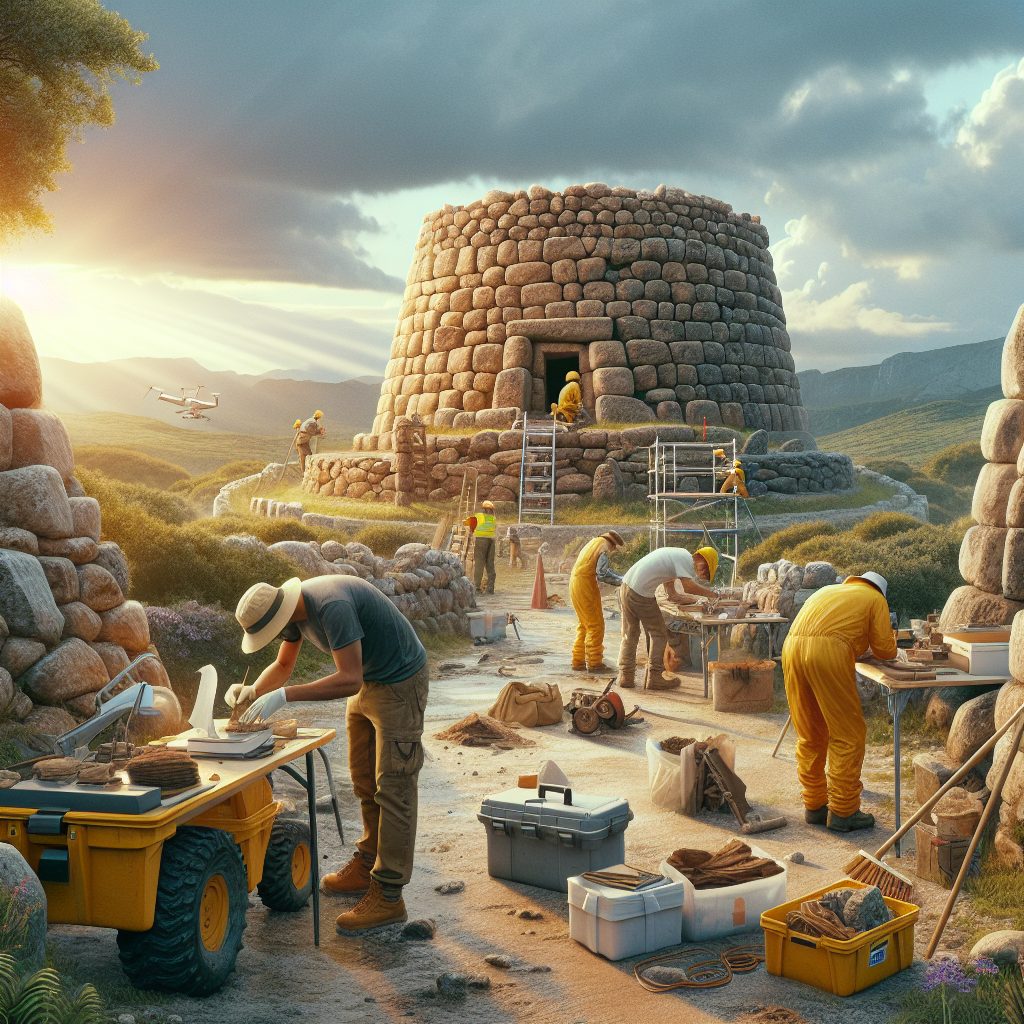Nuraghe Preservation Efforts are crucial for safeguarding the rich cultural heritage of ancient Sardinia. Derived from the prehistoric Nuragic civilization, Nuraghe is the term used to describe the unique ancient stone structures found on the island. These impressive towers, built with large blocks of stone without the use of mortar, are not only architectural marvels but also hold immense historical and archaeological significance.
One remarkable feature of these Nuraghe structures is their sheer number. With over 7,000 nuraghi spread across the Sardinian landscape, they reflect the advanced construction techniques and societal complexity of the ancient Nuragic civilization. Moreover, these structures offer valuable insights into the daily lives, rituals, and cultural practices of the ancient inhabitants. However, despite their historical importance, many Nuraghe sites face threats such as neglect, natural decay, and human interference.
In the upcoming sections of this article, we will delve deeper into the key aspects of Nuraghe preservation efforts. We will explore the challenges faced by conservationists in maintaining and protecting these ancient structures. Additionally, we will discuss the significance of these preservation initiatives in terms of historical research, tourism, and cultural identity. Let us now examine the various key takeaways from these preservation efforts to gain a comprehensive understanding of their importance and impact.
Key Takeaways
1. Nuraghe, ancient stone structures found in Sardinia, Italy, are under threat of deterioration and destruction due to various factors such as natural disasters, looting, and neglect.
2. Conservation efforts have been initiated to preserve and raise awareness about the cultural significance of Nuraghe, which serve as valuable archaeological sites and historical landmarks for studying the island’s prehistoric civilization.
3. Collaboration between international organizations, local communities, and governmental bodies has played a crucial role in launching restoration projects, conducting research, and implementing protective measures for Nuraghe.
4. Advanced technologies like 3D modeling, laser scanning, and remote sensing have been employed to document and analyze the structure of Nuraghe, aiding in their understanding, maintenance, and promotion.
5. Continued education, public engagement, and tourism management programs have been developed to help the local population and visitors appreciate and contribute to the preservation of Nuraghe, ensuring their protection for future generations.
What are the Best Strategies for Nuraghe Preservation Efforts?
1. Understanding the Significance of Nuraghe
Nuraghe is an ancient megalithic structure found in Sardinia, Italy. These unique stone towers served various purposes and are considered significant historical landmarks. To effectively preserve Nuraghe, it is crucial to grasp their cultural, archaeological, and historical importance.
2. Conducting Thorough Surveys and Assessments
Before initiating any preservation efforts, conducting comprehensive surveys and assessments is essential. This process involves evaluating the current condition of Nuraghe, identifying potential threats or damages, and documenting necessary data for preservation planning.
3. Implementing Conservation Techniques
Conservation techniques play a vital role in preserving Nuraghe. The application of appropriate preservation methods, such as stabilization of structures, repairing damages, and mitigating environmental impacts, can help maintain the integrity of these ancient monuments.
4. Developing Preservation Plans
A well-defined preservation plan is crucial for the long-term conservation of Nuraghe. This plan should encompass strategies to protect these structures from natural disasters, human interventions, and climate change. It should also include guidelines for ongoing monitoring, maintenance, and periodic inspections.
5. Promoting Public Awareness and Education
Raising public awareness about the significance of Nuraghe and the importance of their preservation is vital. Educational programs, public campaigns, and guided tours can help inform both locals and tourists about the historical value of these structures, fostering a sense of responsibility towards their conservation.
6. Fostering Collaboration and Partnerships
Preservation efforts for Nuraghe can be strengthened through collaboration between various stakeholders. Working in partnership with archaeological institutions, local communities, governmental bodies, and tourism boards can lead to shared resources, expertise, and effective preservation strategies.
Key Tips for Nuraghe Preservation
- Regularly assess the condition of Nuraghe and address any damages promptly.
- Ensure the use of appropriate conservation materials and techniques for restoration.
- Consider implementing measures to control visitor access and minimize human impact.
- Monitor environmental factors like humidity levels and rainfall to mitigate potential risks.
- Promote sustainable tourism practices near Nuraghe sites to minimize negative impacts.
- Engage local communities in the preservation process and foster their sense of ownership.
- Document and record changes in Nuraghe over time for future research and understanding.
Frequently Asked Questions
1. What are Nuraghe Preservation Efforts?
Nuraghe Preservation Efforts refer to the initiatives taken to protect and conserve the ancient Nuraghe structures found in Sardinia, Italy. These efforts aim to safeguard these unique archaeological sites for future generations.
2. Why is it important to preserve Nuraghe?
Preserving Nuraghe is crucial because these structures are invaluable remnants of Sardinia’s ancient civilization. They provide valuable insights into the island’s rich history, culture, and architectural techniques, enhancing our understanding of the past.
3. How are Nuraghe preserved?
Nuraghe preservation involves several steps. These include conducting archaeological research to gather knowledge about the structures, implementing conservation treatments to stabilize the ruins, and establishing protective measures to prevent further deterioration.
4. Who is responsible for Nuraghe preservation?
The responsibility for Nuraghe preservation falls under the jurisdiction of various authorities, including governmental institutions, local municipalities, and cultural heritage organizations. Additionally, collaborations with archaeologists, conservation experts, and local communities play a vital role in these efforts.
5. What challenges are faced in Nuraghe preservation?
Nuraghe preservation faces challenges such as natural decay due to weather conditions, vandalism, illegal excavations, and insufficient funding. Balancing tourism activities without jeopardizing the integrity of the structures is also a challenge that needs to be addressed.
6. Are there any regulations to protect Nuraghe?
Yes, there are regulations in place to protect Nuraghe sites. These regulations govern activities such as excavation, restoration, and maintenance to ensure that they are carried out in a responsible and sustainable manner, preserving the authenticity of the structures.
7. How can individuals contribute to Nuraghe preservation efforts?
Individuals can contribute to Nuraghe preservation efforts by respecting the sites and following guidelines while visiting. Supporting local initiatives, raising awareness about the importance of these structures, and participating in community-driven projects can also make a significant impact.
8. What is the economic impact of Nuraghe preservation?
Nuraghe preservation has a positive economic impact on local communities. These structures attract tourists, contributing to the growth of cultural tourism. A well-preserved Nuraghe site becomes a significant asset, generating income for the region and supporting local businesses.
9. Are there any ongoing research projects related to Nuraghe preservation?
Yes, several ongoing research projects focused on Nuraghe preservation are being conducted. These projects aim to improve our understanding of these ancient structures, develop innovative conservation techniques, and further explore their historical and cultural significance.
10. How can Nuraghe preservation efforts benefit future generations?
Nuraghe preservation efforts ensure that future generations can continue to study, learn from, and be inspired by these remarkable archaeological sites. By preserving Nuraghe, we pass on a valuable legacy that connects us to our ancestors and fosters pride in our cultural heritage.
Final Thoughts
Nuraghe preservation efforts play a vital role in safeguarding the historical and cultural heritage of Sardinia. These ancient structures are not mere remnants of the past; they are gateways to a fascinating civilization that thrived centuries ago. By preserving Nuraghe, we preserve a part of our collective identity and provide future generations with an opportunity to connect with their roots.
It is essential that the preservation efforts continue to receive support from governments, organizations, and individuals alike. Through collaborative initiatives and sustainable strategies, we can ensure that these awe-inspiring structures stand the test of time, continuing to captivate and inspire generations to come. Nuraghe preservation is not just a responsibility, but also a privilege for all those who appreciate the importance of our shared history.






